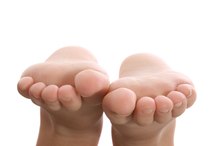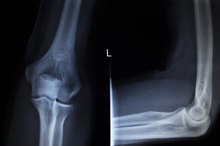Causes of Muscle Pain in the Hands and Feet
Muscle pain is a common health complaint that occurs not only due to damage and inflammation of the affected muscle but also the structures around that muscle such as tendons and ligaments. Muscle pain in the hands and feet is usually the result of overuse, strain or injury of the specific muscle. It may also be associated with other medical conditions such as diabetes, thyroid disease, rheumatoid arthritis as well as muscle diseases such as dermatomyositis and fibromyalgia. The University of Maryland Medical Center notes that muscle pain in the hands, feet and other areas of the body can be debilitating and may require treatment in severe cases.
Muscle Strain
A strain or sprained muscle is an injury that is usually caused by twisting or overstretching the muscle during trauma or in a sports-related accident. Muscle strains in the hands and feet may also be caused by excessive stress and repetitive movements of these joints, explains the National Institute of Arthritis, Musculoskeletal and Skin Diseases. Symptoms of a muscle sprains include moderate pain, swelling, redness and mild limitation of movement of these muscles.
Muscle Cramps
What Are the Symptoms of Torn Tendons?
Learn More
Muscle cramps cause a sudden sharp pain with stiffening of the muscle due to abnormal and involuntary contractions, says MayoClinic.com. This can cause severe pain that lasts for a few minutes or more and is usually relieved by stretching the affected muscle. Muscle cramps typically occur in warmer temperatures and after excessive exercise due to dehydration leading to a drop in body salts that are needed for normal muscle contraction and relaxation. Cramping in the muscles of the hands and feet may also be due to overuse and unnatural posturing for long durations.
- Muscle cramps cause a sudden sharp pain with stiffening of the muscle due to abnormal and involuntary contractions, says MayoClinic.com.
- Muscle cramps typically occur in warmer temperatures and after excessive exercise due to dehydration leading to a drop in body salts that are needed for normal muscle contraction and relaxation.
Tunnel Syndromes
Carpal tunnel syndrome and tarsal tunnel syndrome cause pain in the muscles and joints of the hands and feet, respectively. These conditions are caused by the tightening of the tendon sheaths that surround the nerves passing through them to the joints of the hands and feet. Tunnel syndromes result in pain, tingling, numbness and progressive weakness of the affected muscles and can severely affect function of the hand or foot. Overuse and repetitive movements of the joints can cause these conditions. Tunnel syndromes can also be caused by swelling of the tendon sheaths around the nerves due to pregnancy, autoimmune disease inflammation, osteoarthritis and medical conditions such as diabetes and hypothyroidism.
- Carpal tunnel syndrome and tarsal tunnel syndrome cause pain in the muscles and joints of the hands and feet, respectively.
- These conditions are caused by the tightening of the tendon sheaths that surround the nerves passing through them to the joints of the hands and feet.
Related Articles
References
- MayoClinic.com: Muscle Cramps
- Sprains and Strains by National Institute of Arthritis and Musculoskeletal and Skin Diseases
- Cleveland Clinic: Carpal Tunnel Syndrome
- Cleveland Clinic. Muscle Pain: Possible Causes. Updated December 3, 2017.
- American Academy of Orthopaedic Surgeons. Sprains, Strains and Other Soft-Tissue Injuries. Updated July 2015.
- Allen RE, Kirby KA. Nocturnal leg cramps. Am Fam Physician. 2012;86(4):350-5.
- Jafri MS. Mechanisms of Myofascial Pain. Int Sch Res Notices. 2014;2014:523924. doi:10.1155/2014/523924
- American Academy of Orthopaedic Surgeons. Compartment Syndrome. Updated October 2009.
- Genetic and Rare Diseases Information Center. Pyomyositis.
- Centers for Disease and Prevention. Flu Symptoms & Complications. Updated September 18, 2019.
- Barry AR, Beach JE, Pearson GJ. Prevention and management of statin adverse effects: A practical approach for pharmacists. Can Pharm J (Ott). 2018;151(3):179–188. doi:10.1177/1715163518768534
- Ozaras N, Rezvani A. Diffuse skeletal pain after administration of alendronate. Indian J Pharmacol. 2010;42(4):245–246. doi:10.4103/0253-7613.68435
- Younus J, Kligman L. Management of aromatase inhibitor-induced arthralgia. Curr Oncol. 2010;17(1):87–90. doi:10.3747/co.v17i1.474
- National Institute of Arthritis and Musculoskeletal and Skin Diseases. Fibromyalgia. Updated July 2014.
- Centers for Disease Control and Prevention. What is ME/CFS? Updated July 12, 2018.
- Arthritis Foundation. Polymyalgia Rheumatica.
- Centers for Disease Control and Prevention. Rheumatoid Arthritis (RA). Updated March 5, 2019.
- Merck Manual Professional Version. Systemic Lupus Erythematosus (SLE). Updated Feb 2018.
- National Institute of Neurological Disorders and Stroke. Inflammatory Myopathies Fact Sheet. Updated August 13, 2019.
- National Organization for Rare Disorder. Addison's Disease. Updated 2018.
- Cleveland Clinic. Osteomalacia. Updated August 14, 2018.
- Torres PA, Helmstetter JA, Kaye AM, Kaye AD. Rhabdomyolysis: pathogenesis, diagnosis, and treatment. Ochsner J. 2015;15(1):58–69.
- National Institute of Arthritis and Musculoskeletal and Skin Diseases. Basic facts about muscles. Updated July 2019.
- Biga LM, Dawson S, Harwell A, et al. Chapter 10. Muscle tissue, In: Anatomy & Physiology. XanEdu Publishing Inc; 1st edition; 2013:976-984
- The Myositis Foundation. Polymyositis
- The Myositis Foundation. Dermatomyositis
- Centers for Disease Control and Prevention. What is muscular dystrophy? Updated December 2, 2019
- Myasthenia Gravis Foundation of America, Inc. MG facts
- The ALS Foundation. What is ALS?
- Medline Plus. Rhabdomyolysis. Updated July 16, 2019
- American Heart Association. What is cardiomyopathy in adults? Updated March 31, 2016
- Finsterer J, Löscher WN, Wanschitz J2, et al. Secondary myopathy due to systemic diseases. Acta Neurol Scand. 2016;134(6):388-402. doi:10.1111/ane.12576
- Santilli V, Bernetti A, Mangone M, et al. Clinical definition of sarcopenia. Clin Cases Miner Bone Metab. 2014;11(3): 177–180. doi:10.11138/ccmbm/2014.11.3.177
- The IQVIA Institute for Human Data Science. Understanding neuromuscular disease Care. 2018.
- Brigham and Women’s Hospital. Electromyography
Writer Bio
Noreen Kassem is a hospital doctor and a medical writer. Her articles have been featured in "Women's Health," "Nutrition News," "Check Up" and "Alive Magazine." Kassem also covers travel, books, fitness, nutrition, cooking and green living.








